
Guide
Measuring CO₂ – what meters can and cannot do
by Martin Jungfer

Blue, green, yellow, red – these are the four colours the swiss-made meter named «Wuerfeli» uses. It measures the CO₂ content of the air and successfully motivates me to ventilate my home.
Since the pandemic, the number of devices that measure and display the CO₂ content of indoor air has increased enormously. I recently wrote about some CO₂ meters from our range:
At the time, I didn’t include a swiss-made product that’s actually quite interesting. It’s called «Wuerfeli», which is Swiss German for «small cube». The technology is the same as with many other devices: it’s equipped with a sensor that measures the CO₂ content of the air in a room. Depending on the result, a diode then lights up and signals either that everything’s OK or that it’s time to air out the room.
The «Wuerfeli» features a sensor from Sensirion. More precisely, the SCD40, which according to Sensirion, is the smallest CO₂ sensor in the world. That’s also why the «Wuerfeli»’s particularly small. The pyramid’s 2.75 cm high and has a square base of three centimetres per side. The ancient Egyptians would have loved to see this. But wait, didn’t we say it’s called «small cube»? How come it’s shaped like a pyramid? My thoughts exactly.
As Laurin Schwitter, Managing Director of QE GmbH from Landquart, the company behind the sensor, explained to me, the project name for the product was «Würfeli», derived from the cubic shape of Sensirion’s SCD40 chip. Later, the housing was designed, which wasn’t cube-shaped at all. But the name stuck.
While it made me think of ancient pyramids in Egypt, the product designers had the Louvre in Paris in mind. «It also lights up beautifully at night,» Laurin says.
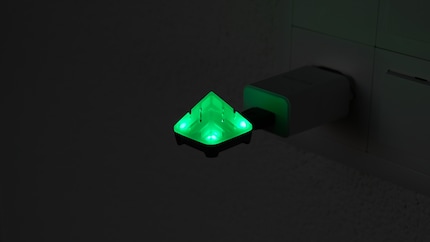
Let’s get over its shape and focus on its function. The SCD40 chip in the pyramid measures the number of CO₂ particles in the air every five seconds. It sits on a small circuit board that controls an LED. This illustration (in German) shows exactly how it works.
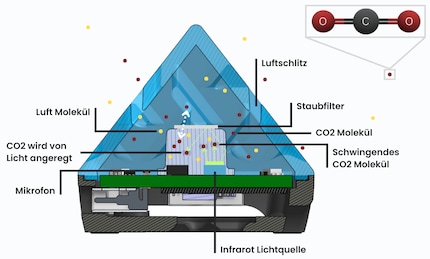
The result of the measurement is then displayed by the «Wuerfeli» lighting up in one of these colours:
Other manufacturers also use green, orange and red, but blue is a «Wuerfeli»-specific extension of the colour scale. It’s a practical way of determining how long a room needs to be aired out. How come? Well, the maximum value of 550 ppm for the blue light is close to the value for outside air. This means once the pyramid lights up blue, there’s enough fresh air in the room and you can close the window, making sure you don’t lose more heat than necessary.
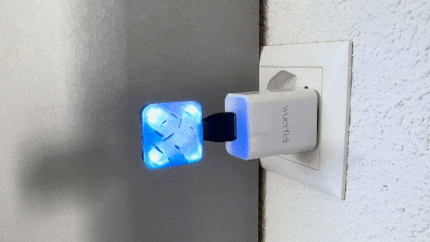
There’s something else that makes the «Wuerfeli» special: its light pulsates. Or, as the inventors call it, it breathes. This indicates there’s a lot of air exchange – as it would in the case of short, intense airing with all windows open. The LED in the small pyramid then pulsates at short intervals, while changing from red to orange, green and then blue. The pulsating helps to ventilate effectively. Tilting one window is much less effective than opening many windows at the same time. Ideally, you can even create a draught to speed things up, as this allows a lot of stale air to leave the room and fresh air to get in. You’ll find more about the physical principle of ventilation on this page by «Wuerfeli» (only available in German).
When testing the «Wuerfeli», I made sure to open several windows at once in order to see the pulsating. As a nice side effect, it meant I didn’t have to leave the windows open for as long, and the room didn’t cool down as much. I got fresh air without the walls and furniture cooling down.
Other CO₂ meters I’ve tested usually also showed me an absolute CO₂ value. The «Wuerfeli» doesn’t and I feared I’d miss that. But I didn’t. The colour scale is more than enough. I know that red and orange means the room needs fresh air. Whether the CO₂ content in the room air is 1,550 or 1,709 ppm doesn’t change my behaviour.
Or as «Wuerfeli» co-inventor Laurin explains it:
Reading the numbers, interpreting them and then acting is too complicated. Colours are emotional and simple.
According to Laurin, various studies carried out in public buildings have shown that rooms with colour code sensors are ventilated more effectively than those with numerical displays. This applies to schools, hospitals and offices, where there are already many «Wuerfeli» meters.
For the «Wuerfeli» makers, the concept of simplicity also includes not using an app. Technically, it’s possible to log the data and, according to Laurin, the data was recorded during the test phase before the official sales launch to make sure the colour concept worked. Ultimately, however, the data and graphs that can be generated are only interesting for a short time. When I think about the way I use it, I agree. I’ve definitely lost interest in my Netatmo app, which I used to check several times a day right after I installed a few devices.
Ideally, find a permanent place for the sensor in your home. It should be where you can see it easily at all times, but ideally not directly next to a window or heater. The «Wuerfeli»’s powered through a two-metre-long white cable, leading to the USB power supply for the socket. You can either attach the sensor to a shelf with adhesive dots or nail it to the wall.
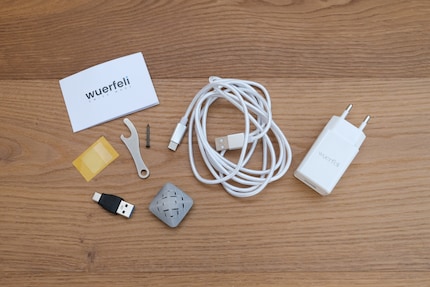
By the way, you don’t have to worry about the sensor ruining your movie night because it’s flashing in bright lights. It’s equipped with a brightness sensor and dims if it’s dark in the room. At night, in complete darkness, the light even switches off. This means you could even have one in your bedroom.
You don’t like the cable and would like to plug it into a socket permanently? If so, I recommend the version with direct connection. It includes a USB-A to USB-C adapter and connects the «Wuerfeli» to the power supply unit without needing a cable. In theory, you could even connect it to a power bank and set it up somewhere else every day or take it to the office.
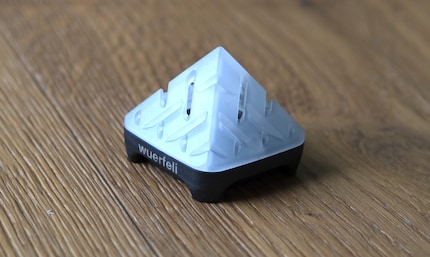
I’ve already mentioned the sensor’s produced by a Swiss company. What I find even more impressive is that the entire product is made in Switzerland. The Sensirion sensor’s made in Stäfa, the circuit board in Bubikon, the housing in Ruswil and the fabric bag in Kriens. Only the mains plug and the cable come from China. At least the latter contains recycled plastic. And for every «Wuerfeli» that’s sold, the company donates one Swiss franc to projects that collect plastic waste.
In addition to the made-in-Switzerland approach, you can be sure the «Wuerfeli» will last a long time. It has a service life of ten years, according to the manufacturer. Apparently, special maintenance algorithms are designed to ensure measurements are accurate for a long time. It’s easy to check if your device is still working well. Take it outside and it should light up blue. If it doesn’t or something else is wrong, you can send it to the manufacturer who’ll check and calibrate it for free.
100 francs for a CO₂ sensor that has fewer features than others such as the Aranet 4? Before doing my review, I was sceptical as to whether this was a good investment. My opinion changed during the test. The four colours of the «Wuerfeli» are enough to motivate me to air out my home regularly. I didn’t miss the app or other logged data for a second. I can now see how the «Wuerfeli» is a great choice for classrooms.
The only thing I found a bit tricky was finding a suitable place for the sensor, as I’m not a fan of visible cables. That’s why I ultimately opted for the direct connection version. Now the little pyramid is plugged into a socket next to a dresser, reliably doing its job 24/7.
Pro
Contra
Journalist since 1997. Stopovers in Franconia (or the Franken region), Lake Constance, Obwalden, Nidwalden and Zurich. Father since 2014. Expert in editorial organisation and motivation. Focus on sustainability, home office tools, beautiful things for the home, creative toys and sports equipment.